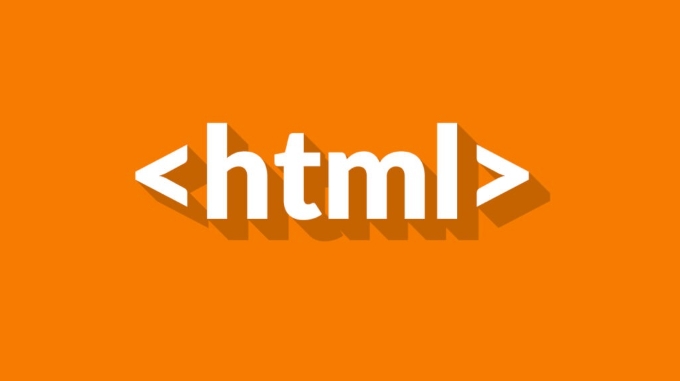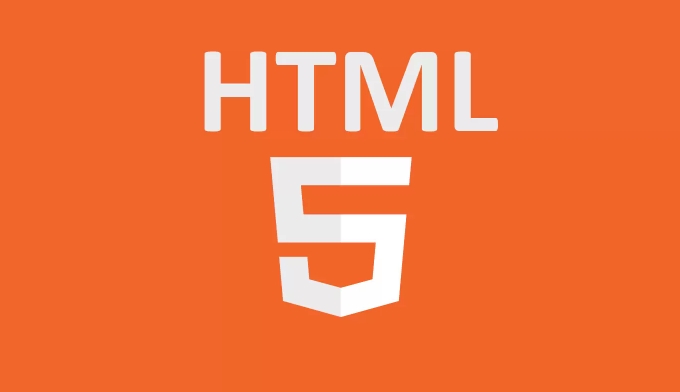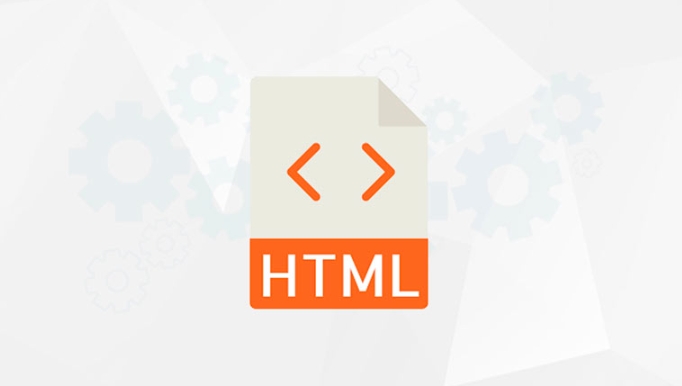How to add an image to a webpage using HTML5?
Jul 27, 2025 am 02:46 AMThe core method of adding images to a web page is to use the <img src="/static/imghw/default1.png" data-src="https://img.php.cn/upload/article/000/000/000/175355560396668.jpeg" class="lazy" alt="How to add an image to a webpage using HTML5?" > tag and match the necessary attributes. First, use the self-closed <img src="/static/imghw/default1.png" data-src="https://img.php.cn/upload/article/000/000/000/175355560396668.jpeg" class="lazy" alt="How to add an image to a webpage using HTML5?" > tag, and specify the image path through the src attribute, and provide alternative text; second, you can wrap the image through the <a> tag to achieve click jump; again, use the new <figure> and <figcaption> tags added by HTML5 to structure the image and title; in addition, you can set width, height or use CSS to control the image size, and achieve lazy loading through loading="lazy" to optimize performance.

Adding images to web pages is one of the basic operations of HTML, and HTML5 provides more concise and semantic tags and attributes to achieve this. The most core way is to use the <img src="/static/imghw/default1.png" data-src="https://img.php.cn/upload/article/000/000/000/175355560420539.jpeg" class="lazy" alt="How to add an image to a webpage using HTML5?" > tag and match src and alt attributes.

Basic writing method: use the <img src="/static/imghw/default1.png" data-src="https://img.php.cn/upload/article/000/000/000/175355560396668.jpeg" class="lazy" alt="How to add an image to a webpage using HTML5?" > tag
The easiest and most straightforward way to insert an image into a web page is to use the HTML <img src="/static/imghw/default1.png" data-src="https://img.php.cn/upload/article/000/000/000/175355560396668.jpeg" class="lazy" alt="How to add an image to a webpage using HTML5?" > tag. This tag is a self-closing tag, which means no additional end tag is required.
Example:

<img src="/static/imghw/default1.png" data-src="example.jpg" class="lazy" alt="descriptive text">
-
srcis a must, it tells the browser the location of the image file. -
altis also recommended to write. This alternative text will be displayed when the image cannot be loaded, and it is also important for barrier-free access.
The path can be a relative path (such as images/photo.jpg ), or an absolute path or network address (such as https://example.com/photo.jpg ).
Add image link: wrap <img src="/static/imghw/default1.png" data-src="https://img.php.cn/upload/article/000/000/000/175355560668748.jpeg" class="lazy" alt="How to add an image to a webpage using HTML5?" > with <a>
If you want the image to be clicked and redirected to another page or resource, you can put <img src="/static/imghw/default1.png" data-src="https://img.php.cn/upload/article/000/000/000/175355560668748.jpeg" class="lazy" alt="How to add an image to a webpage using HTML5?" > in the <a> tag.

Example:
<a href="https://example.com"> <img src="/static/imghw/default1.png" data-src="logo.png" class="lazy" alt="Company Logo"> </a>
In this way, users can jump to the specified link by clicking on the image. This practice is often used for website logo or advertising graphics display.
Add titles using <figure> and <figcaption> (New in HTML5)
HTML5 introduces <figure> and <figcaption> tags to display pictures and their explanatory texts more structured, which is particularly suitable for mixed text content.
Example:
<figure> <img src="/static/imghw/default1.png" data-src="nature.jpg" class="lazy" alt="Natural Landscape"> <figcaption>Beautiful mountain scenery</figcaption> </figure>
-
<figure>means a separate content block, usually related to the main content but can exist separately. -
<figcaption>is its child element used to add a title or description to the image.
This method not only makes the code clearer, but also improves semantics and SEO effects.
Image size control and other properties
You can control the size of the image by setting width and height properties:
<img src="/static/imghw/default1.png" data-src="photo.jpg" class="lazy" alt="personal photo" style="max-width:90%" style="max-width:90%">
However, it is recommended to use CSS to control the size, so that the style and structure are separated, making it easier to maintain:
<img src="/static/imghw/default1.png" data-src="photo.jpg" class="lazy" alt="personal photo" style="max-width:90%">
In addition, you can also use loading="lazy" to delay loading of images to improve page loading speed:
<img src="/static/imghw/default1.png" data-src="big-image.jpg" class="lazy" alt="large image" loading="lazy">
Basically that's it. Although adding images seems simple, in actual development, whether the path is correct, whether the alternative text is appropriate, and whether the responsive processing is in place will affect the user experience and accessibility.
The above is the detailed content of How to add an image to a webpage using HTML5?. For more information, please follow other related articles on the PHP Chinese website!

Hot AI Tools

Undress AI Tool
Undress images for free

Undresser.AI Undress
AI-powered app for creating realistic nude photos

AI Clothes Remover
Online AI tool for removing clothes from photos.

Clothoff.io
AI clothes remover

Video Face Swap
Swap faces in any video effortlessly with our completely free AI face swap tool!

Hot Article

Hot Tools

Notepad++7.3.1
Easy-to-use and free code editor

SublimeText3 Chinese version
Chinese version, very easy to use

Zend Studio 13.0.1
Powerful PHP integrated development environment

Dreamweaver CS6
Visual web development tools

SublimeText3 Mac version
God-level code editing software (SublimeText3)
 Handling reconnections and errors with HTML5 Server-Sent Events.
Jul 03, 2025 am 02:28 AM
Handling reconnections and errors with HTML5 Server-Sent Events.
Jul 03, 2025 am 02:28 AM
When using HTML5SSE, the methods to deal with reconnection and errors include: 1. Understand the default reconnection mechanism. EventSource retrys 3 seconds after the connection is interrupted by default. You can customize the interval through the retry field; 2. Listen to the error event to deal with connection failure or parsing errors, distinguish error types and execute corresponding logic, such as network problems relying on automatic reconnection, server errors manually delay reconnection, and authentication failure refresh token; 3. Actively control the reconnection logic, such as manually closing and rebuilding the connection, setting the maximum number of retry times, combining navigator.onLine to judge network status to optimize the retry strategy. These measures can improve application stability and user experience.
 Integrating CSS and JavaScript effectively with HTML5 structure.
Jul 12, 2025 am 03:01 AM
Integrating CSS and JavaScript effectively with HTML5 structure.
Jul 12, 2025 am 03:01 AM
HTML5, CSS and JavaScript should be efficiently combined with semantic tags, reasonable loading order and decoupling design. 1. Use HTML5 semantic tags, such as improving structural clarity and maintainability, which is conducive to SEO and barrier-free access; 2. CSS should be placed in, use external files and split by module to avoid inline styles and delayed loading problems; 3. JavaScript is recommended to be introduced in front, and use defer or async to load asynchronously to avoid blocking rendering; 4. Reduce strong dependence between the three, drive behavior through data-* attributes and class name control status, and improve collaboration efficiency through unified naming specifications. These methods can effectively optimize page performance and collaborate with teams.
 Receiving real-time data with HTML5 Server-Sent Events (SSE).
Jul 02, 2025 pm 04:46 PM
Receiving real-time data with HTML5 Server-Sent Events (SSE).
Jul 02, 2025 pm 04:46 PM
Server-SentEvents (SSE) is a lightweight solution provided by HTML5 to push real-time updates to the browser. It realizes one-way communication through long HTTP connections, which is suitable for stock market, notifications and other scenarios. Create EventSource instance and listen for messages when using: consteventSource=newEventSource('/stream'); eventSource.onmessage=function(event){console.log('Received message:',event.data);}; The server needs to set Content-Type to text/event
 Declaring the correct HTML5 doctype for modern pages.
Jul 03, 2025 am 02:35 AM
Declaring the correct HTML5 doctype for modern pages.
Jul 03, 2025 am 02:35 AM
Doctype is a statement that tells the browser which HTML standard to use to parse the page. Modern web pages only need to be written at the beginning of the HTML file. Its function is to ensure that the browser renders the page in standard mode rather than weird mode, and must be located on the first line, with no spaces or comments in front of it; there is only one correct way to write it, and it is not recommended to use old versions or other variants; other such as charset, viewport, etc. should be placed in part.
 Improving SEO with HTML5 semantic markup and Microdata.
Jul 03, 2025 am 01:16 AM
Improving SEO with HTML5 semantic markup and Microdata.
Jul 03, 2025 am 01:16 AM
Using HTML5 semantic tags and Microdata can improve SEO because it helps search engines better understand page structure and content meaning. 1. Use HTML5 semantic tags such as,,,, and to clarify the function of page blocks, which helps search engines establish a more accurate page model; 2. Add Microdata structured data to mark specific content, such as article author, release date, product price, etc., so that search engines can identify information types and use them for display of rich media summary; 3. Pay attention to the correct use of tags to avoid confusion, avoid duplicate tags, test the effectiveness of structured data, regularly update to adapt to changes in schema.org, and combine with other SEO means to optimize for long-term.
 What are the best practices for structuring an HTML5 document?
Jun 26, 2025 am 01:03 AM
What are the best practices for structuring an HTML5 document?
Jun 26, 2025 am 01:03 AM
To build standardized and clear HTML5 documents, the following best practices must be followed: 1. Use standard document type declarations; 2. Build a basic skeleton including three tags and pay attention to the character set, title and script location; 3. Use semantic tags such as , , to improve accessibility and SEO; 4. Reasonably nest the title levels to ensure that the structure is clear and there is only one per page. These steps help improve code quality, collaboration efficiency and user experience.
 Explaining the HTML5 `` vs `` elements.
Jul 12, 2025 am 03:09 AM
Explaining the HTML5 `` vs `` elements.
Jul 12, 2025 am 03:09 AM
It is a block-level element, suitable for layout; it is an inline element, suitable for wrapping text content. 1. Exclusively occupy a line, width, height and margins can be set, which are often used in structural layout; 2. No line breaks, the size is determined by the content, and is suitable for local text styles or dynamic operations; 3. When choosing, it should be judged based on whether the content needs independent space; 4. It cannot be nested and is not suitable for layout; 5. Priority is given to the use of semantic labels to improve structural clarity and accessibility.
 Getting the user's current location with the HTML5 Geolocation API.
Jul 02, 2025 pm 05:03 PM
Getting the user's current location with the HTML5 Geolocation API.
Jul 02, 2025 pm 05:03 PM
When using HTML5Geolocation API to obtain user location, you must first obtain user authorization, and request and explain the purpose at the right time; the basic method is navigator.geolocation.getCurrentPosition(), which contains successful callbacks, wrong callbacks and configuration parameters; common reasons for failure include permission denied, browser not supported, network problems, etc., alternative solutions and clear prompts should be provided. The specific suggestions are as follows: 1. Request permissions when the user operation is triggered, such as clicking the button; 2. Use enableHighAccuracy, timeout, maximumAge and other parameters to optimize the positioning effect; 3. Error handling should distinguish between different errors






